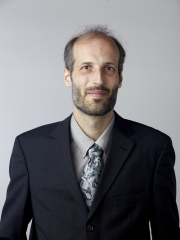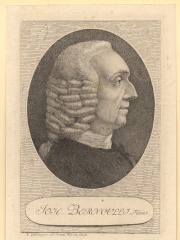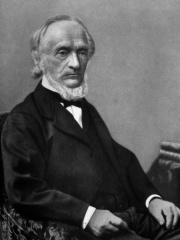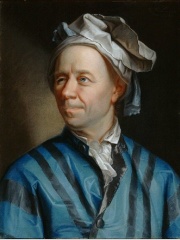
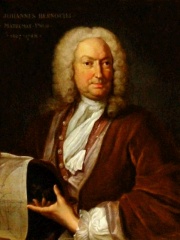
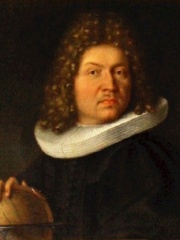
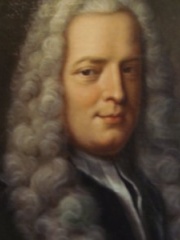
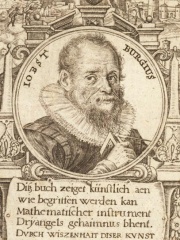
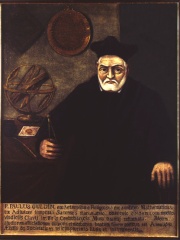
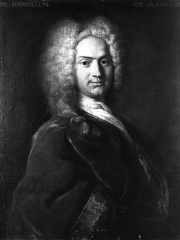

The Most Famous
MATHEMATICIANS from Switzerland
This page contains a list of the greatest Swiss Mathematicians. The pantheon dataset contains 823 Mathematicians, 20 of which were born in Switzerland. This makes Switzerland the birth place of the 9th most number of Mathematicians behind Poland and Ukraine.
Top 10
The following people are considered by Pantheon to be the top 10 most legendary Swiss Mathematicians of all time. This list of famous Swiss Mathematicians is sorted by HPI (Historical Popularity Index), a metric that aggregates information on a biography’s online popularity. Visit the rankings page to view the entire list of Swiss Mathematicians.

1. Leonhard Euler (1707 - 1783)
With an HPI of 84.57, Leonhard Euler is the most famous Swiss Mathematician. His biography has been translated into 152 different languages on wikipedia.
Leonhard Euler ( OY-lər, German: [ˈleːɔnhaʁt ˈʔɔʏlɐ] , Swiss Standard German: [ˈleːɔnhart ˈɔʏlər]; 15 April 1707 – 18 September 1783) was a Swiss mathematician, physicist, astronomer, geographer, logician, and engineer who founded the studies of graph theory and topology and made pioneering and influential discoveries in many other branches of mathematics such as analytic number theory, complex analysis, and infinitesimal calculus. He introduced much of modern mathematical terminology and notation, including the notion of a mathematical function. He is also known for his work in mechanics, fluid dynamics, optics, astronomy, and music theory. Euler is held to be one of the greatest mathematicians in history and the greatest of the 18th century. Several great mathematicians who produced their work after Euler's death have recognised his importance in the field as shown by quotes attributed to many of them: Pierre-Simon Laplace expressed Euler's influence on mathematics by stating, "Read Euler, read Euler, he is the master of us all." Carl Friedrich Gauss wrote: "The study of Euler's works will remain the best school for the different fields of mathematics, and nothing else can replace it." Euler is also widely considered to be the most prolific; his 866 publications as well as his correspondences are being collected in the Opera Omnia Leonhard Euler which, when completed, will consist of 81 quarto volumes. He spent most of his adult life in Saint Petersburg, Russia, and in Berlin, then the capital of Prussia. Euler is credited for popularizing the Greek letter π {\displaystyle \pi } (lowercase pi) to denote the ratio of a circle's circumference to its diameter, as well as first using the notation f ( x ) {\displaystyle f(x)} for the value of a function, the letter i {\displaystyle i} to express the imaginary unit − 1 {\displaystyle {\sqrt {-1}}} , the Greek letter Σ {\displaystyle \Sigma } (capital sigma) to express summations, the Greek letter Δ {\displaystyle \Delta } (capital delta) for finite differences, and lowercase letters to represent the sides of a triangle while representing the angles as capital letters. He gave the current definition of the constant e {\displaystyle e} , the base of the natural logarithm, now known as Euler's number. Euler is also credited with being the first to develop graph theory (partly as a solution for the problem of the Seven Bridges of Königsberg, which is also considered the first practical application of topology). He also became famous for, among many other accomplishments, providing a solution to several unsolved problems in number theory and analysis, including the Basel problem, which had remained unsolved for 150 years. The Basel problem consists of finding the sum of the reciprocals of the squares of the natural numbers. Euler found that this sum equals exactly π2/6. Euler has also been credited for discovering that the sum of the numbers of vertices and faces minus the number of edges of a polyhedron equals 2, a number now commonly known as the Euler characteristic. In the field of physics, Euler reformulated Newton's laws of physics into new laws in his two-volume work Mechanica to better explain the motion of rigid bodies. He also made substantial contributions to the study of elastic deformations of solid objects.

2. Johann Bernoulli (1667 - 1748)
With an HPI of 71.44, Johann Bernoulli is the 2nd most famous Swiss Mathematician. His biography has been translated into 64 different languages.
Johann Bernoulli (also known as Jean in French or John in English; 6 August [O.S. 27 July] 1667 – 1 January 1748) was a Swiss mathematician and was one of the many prominent mathematicians in the Bernoulli family. He is known for his contributions to infinitesimal calculus and educating Leonhard Euler in the pupil's youth.

3. Jacob Bernoulli (1654 - 1705)
With an HPI of 67.90, Jacob Bernoulli is the 3rd most famous Swiss Mathematician. His biography has been translated into 70 different languages.
Jacob Bernoulli (also known as James in English or Jacques in French; 6 January 1655 [O.S. 27 December 1654] – 16 August 1705) was one of the many prominent mathematicians in the Swiss Bernoulli family. He sided with Gottfried Wilhelm Leibniz during the Leibniz–Newton calculus controversy and was an early proponent of Leibnizian calculus, which he made numerous contributions to; along with his brother Johann, he was one of the founders of the calculus of variations. He also discovered the fundamental mathematical constant e. However, his most important contribution was in the field of probability, where he derived the first version of the law of large numbers in his work Ars Conjectandi.

4. Gabriel Cramer (1704 - 1752)
With an HPI of 64.79, Gabriel Cramer is the 4th most famous Swiss Mathematician. His biography has been translated into 38 different languages.
Gabriel Cramer (French: [kʁamɛʁ]; 31 July 1704 – 4 January 1752) was a Genevan mathematician. He was the son of physician Jean Cramer and Anne Mallet Cramer.
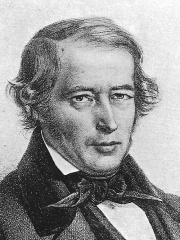
5. Jakob Steiner (1796 - 1863)
With an HPI of 61.38, Jakob Steiner is the 5th most famous Swiss Mathematician. His biography has been translated into 33 different languages.
Jakob Steiner (18 March 1796 – 1 April 1863) was a Swiss mathematician who worked primarily in geometry.

6. Jost Bürgi (1552 - 1632)
With an HPI of 60.75, Jost Bürgi is the 6th most famous Swiss Mathematician. His biography has been translated into 27 different languages.
Jost Bürgi (also Joost, Jobst; Latinized surname Burgius or Byrgius; 28 February 1552 – 31 January 1632), active primarily at the courts in Kassel and Prague, was a Swiss clockmaker, a maker of astronomical instruments and a mathematician.

7. Paul Guldin (1577 - 1643)
With an HPI of 59.63, Paul Guldin is the 7th most famous Swiss Mathematician. His biography has been translated into 25 different languages.
Paul Guldin (born Habakkuk Guldin; 12 June 1577 (Mels) – 3 November 1643 (Graz)) was a Swiss Jesuit mathematician and astronomer. He discovered the Guldinus theorem to determine the surface and the volume of a solid of revolution. (This theorem is also known as the Pappus–Guldinus theorem and Pappus's centroid theorem, attributed to Pappus of Alexandria.) Guldin was noted for his association with the German mathematician and astronomer Johannes Kepler. Guldin composed a critique of Cavalieri's method of Indivisibles. Although of Jewish descent, his parents were Protestants and they brought Guldin up in that faith. He was a professor of mathematics in Graz and Vienna. In Paolo Casati's astronomical work Terra machinis mota (1658), Casati imagines a dialogue among Guldin, Galileo, and Marin Mersenne on various intellectual problems of cosmology, geography, astronomy and geodesy.

8. Nicolaus II Bernoulli (1695 - 1726)
With an HPI of 57.24, Nicolaus II Bernoulli is the 8th most famous Swiss Mathematician. His biography has been translated into 27 different languages.
Nicolaus II Bernoulli (also spelled as Niklaus or Nikolaus; 6 February 1695 in Basel – 31 July 1726 in Saint Petersburg) was a Swiss mathematician as were his father Johann Bernoulli and one of his brothers, Daniel Bernoulli. He was one of the many prominent mathematicians in the Bernoulli family.

9. Jean-Robert Argand (1768 - 1822)
With an HPI of 56.76, Jean-Robert Argand is the 9th most famous Swiss Mathematician. His biography has been translated into 29 different languages.
Jean-Robert Argand (UK: , US: , French: [ʒɑ̃ ʁɔbɛʁ aʁɡɑ̃]; July 18, 1768 – August 13, 1822) was a Genevan amateur mathematician. In 1806, while managing a bookstore in Paris, he published the idea of geometrical interpretation of complex numbers known as the Argand diagram and is known for the first rigorous proof of the Fundamental Theorem of Algebra.
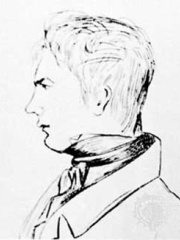
10. Jacques Charles François Sturm (1803 - 1855)
With an HPI of 54.78, Jacques Charles François Sturm is the 10th most famous Swiss Mathematician. His biography has been translated into 29 different languages.
Jacques Charles François Sturm (29 September 1803 – 15 December 1855) was a French mathematician, who made a significant addition to equation theory with his work, Sturm's theorem.
Pantheon has 20 people classified as mathematicians born between 1552 and 1975. Of these 20, 1 (5.00%) of them are still alive today. The most famous living mathematicians include Martin Hairer. The most famous deceased mathematicians include Leonhard Euler, Johann Bernoulli, and Jacob Bernoulli. As of April 2022, 1 new mathematicians have been added to Pantheon including Ludwig Schläfli.
Living Mathematicians
Go to all RankingsDeceased Mathematicians
Go to all Rankings
Leonhard Euler
1707 - 1783
HPI: 84.57
Johann Bernoulli
1667 - 1748
HPI: 71.44
Jacob Bernoulli
1654 - 1705
HPI: 67.90
Gabriel Cramer
1704 - 1752
HPI: 64.79
Jakob Steiner
1796 - 1863
HPI: 61.38
Jost Bürgi
1552 - 1632
HPI: 60.75
Paul Guldin
1577 - 1643
HPI: 59.63
Nicolaus II Bernoulli
1695 - 1726
HPI: 57.24
Jean-Robert Argand
1768 - 1822
HPI: 56.76
Jacques Charles François Sturm
1803 - 1855
HPI: 54.78
Simon Antoine Jean L'Huilier
1750 - 1840
HPI: 52.59
Johann II Bernoulli
1710 - 1790
HPI: 52.40

Newly Added Mathematicians (2022)
Go to all RankingsWhich Mathematicians were alive at the same time? This visualization shows the lifespans of the 11 most globally memorable Mathematicians since 1700.

